The 5 Best Survival Axes
The Axe is one of the most underrated cutting tools that should be in a survivalist’s bug-out bag, the hype around the survivalist knife has blinded people to the benefits that an axe provides. Here are the The 5 Best Survival Axes.
In the right hands, a good axe can perform many of the tasks of a survival knife, a woodsman that is sufficiently skilled with the use of an axe can choke up on it and use it for more delicate work such as field dressing big game, carving, shaving feather sticks, and even food prep (if no other tools are available), I have even seen people shave with an axe, although I think that is taking things a little far.
Difference Between a Hatchet and Axe.
A hand axe or hatchet would be defined as a smaller more compact version of an axe, usually designed to be wielded one-handed, while an axe being slightly larger would be swung with two hands on the handle.
Some people are of the opinion that a hatchet has a hammerhead on the opposite side of the blade (the poll), and that separates the hatchet from a hand axe, I haven’t noticed that distinction, often a hatched does have a hammerhead on the poll, but not always, I have seen products marketed as hatchets that look identical to handaxes and vice versa.
In forested environments, a combination, of knife and axe is pretty much the sweet spot of cutting tools, in a jungle environment the combination of machete and knife would be better.
Gransfors Bruks Wildlife Hatchet
This is in my opinion the perfect size, weight, and design for a survival axe(hatchet). If well looked after this will be a heirloom item that can be passed down for generations. Handmade with the blacksmith’s initials in the axe head. This is the gold standard of bushcraft and one of the best survival axes.
Made in Sweden, this little beauty is about 13 inches long from heel to eye, weighs about 0.6kg, and comes with a leather mask. The beard is perfect for choking up on for controlled carving, unlike many mass-produced axes, Gransfors Bruks Axes are sharp right out of the box. This is the perfect lightweight survival hatchet. but if you are willing to carry something a little bit heavier, than go for the Gransfor Bruks Small Forest axe.
Pros
Quality
Razor Sharp out of the box
Real Heirloom Purchase
Cons
Expensive
The mask could be sturdier
The Fiskars X10
Fiskars X10 is a non-traditional axe, the handle is not made of wood, but of plastic, well.. a fiberglass reinforced plastic that is stronger than wood. The advantages are, less maintenance, a stronger handle, the handle absorbs vibrations better than a wooden handle, the lightweight of the handle in contrast to the heavy head of the axe, gives a great swing to the axe, and surprisingly good cutting power for such a budget-friendly axe.
While this is a great budget axe, there are some disadvantages, once the plastic handle breaks the axe is unfixable, the axehead is made of soft metal so the axe needs to be resharpened often and due to the shape of the axehead, choking up on it and using it for finer work such as carving is awkward. But if your aim is to have a decent budget axe for chopping wood, this is the axe for you.
Pros
Best in its price range, truly budget-friendly
Durable
Reasonably Sharp out of the box
Cons
Once the handle is broken, the axe is scrap metal
Needs to be re-sharpened often
Not designed for fine work
SOG
A favorite amongst campers this little hatchet is the perfect camp tool, lightweight, good for pounding in tent stakes and making kindling for a fire, it is just over a pound in weight, about 11.5″, with a really good shape for choking up on it and carving.
The SOG axe would make a great present for a budding young survivalist to train with, it is, however, a little bit too small to be used as a real survivalist axe, in my opinion, it is for light use only.
Pros
Compact
Lightweight
relatively sturdy for its size and weight
Pretty
Cons
Only for very light use around a camp
Relatively expensive
Hultafors Hultån Hatchet
Hultafors Hultan hatchet is a classic outdoors camp axe, small, light, sturdy, and razor-sharp, I am surprised that I so rarely see this axe being mentioned among bushcrafter and survivalists, the Hultan is a slightly longer and heavier axe than the Gransfors Wilderness hatchet, the axe weights a good 800gm, is about 14.5″ long and comes with a beautiful hickory handle.
Pros
Mask is beautiful
Quality
Chops well
Cons
Expensive
Choking up on it isn’t that comfortable
Estwing Sportsman’s Axe
Made in the USA, that would be its first selling point for many people, the second selling point would be that it is made of a solid piece of about 12.5″ to 13.5″ of steel (full tang), so no worrying about the wooden handle rotting, or the axe head getting loose, maintenance is minimal, wipe down the axe after use, if the lacquer on the leather starts wearing out, make sure to treat the leather handle so it doesn’t get wet and rot.
Pros
Small portable hatchet
Solid piece of metal from handle to axe head, full tang axe
poll can be used to hammer in tent stakes
Cons
Heavy for an axe this size
Quality control issues
Terrible Nylon Mask
Axe Head Shape
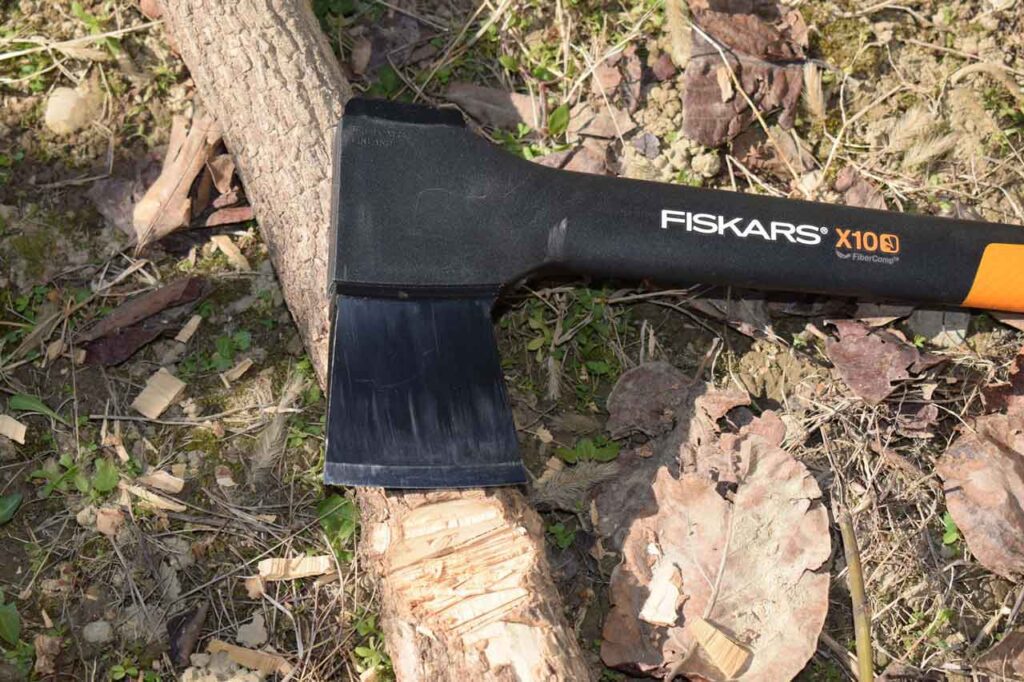
Axe head shapes define their uses, many axes are designed for a specific task, such as a carpenters axe, a wood splitting axe (or maul if you want to be precise, or a rescue axe.
We won’t be discussing these specialized axes, as we are looking for a general all-purpose axe, that is suitable for a survival bag.
Our requirements will be that the axe is more a jack of all trades, and master of none.
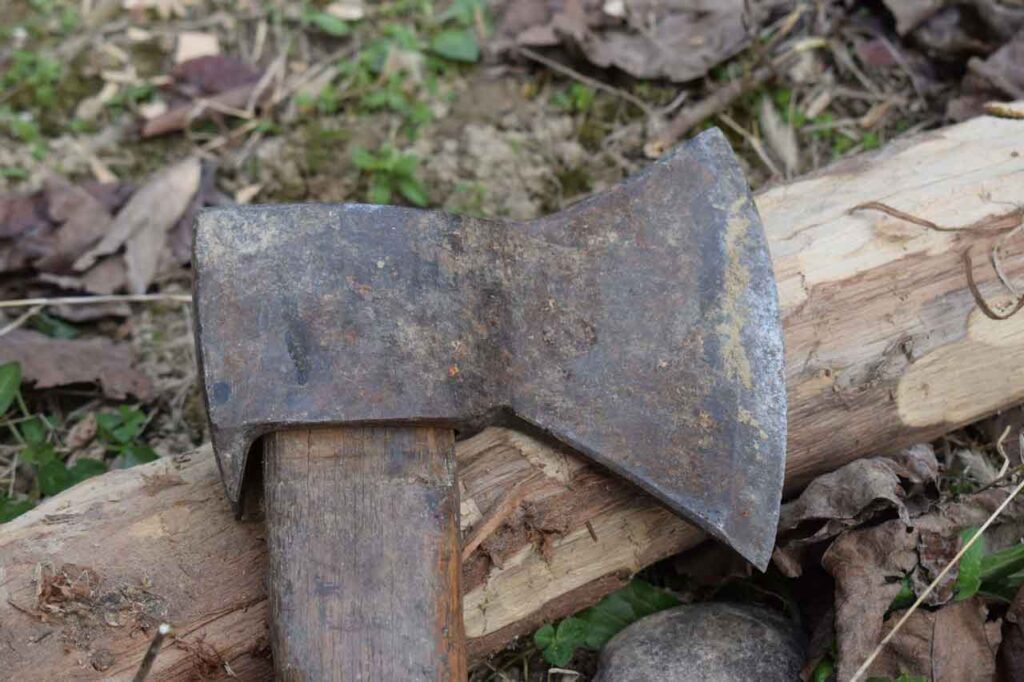
Poll
The poll of the axe (the part opposite the blade, different axes have different shaped polls, the most common is the hammerhead shaped polls, then, of course, there is the spiked and the curved hammerhead.
Can I Use an Axe as a Hammer
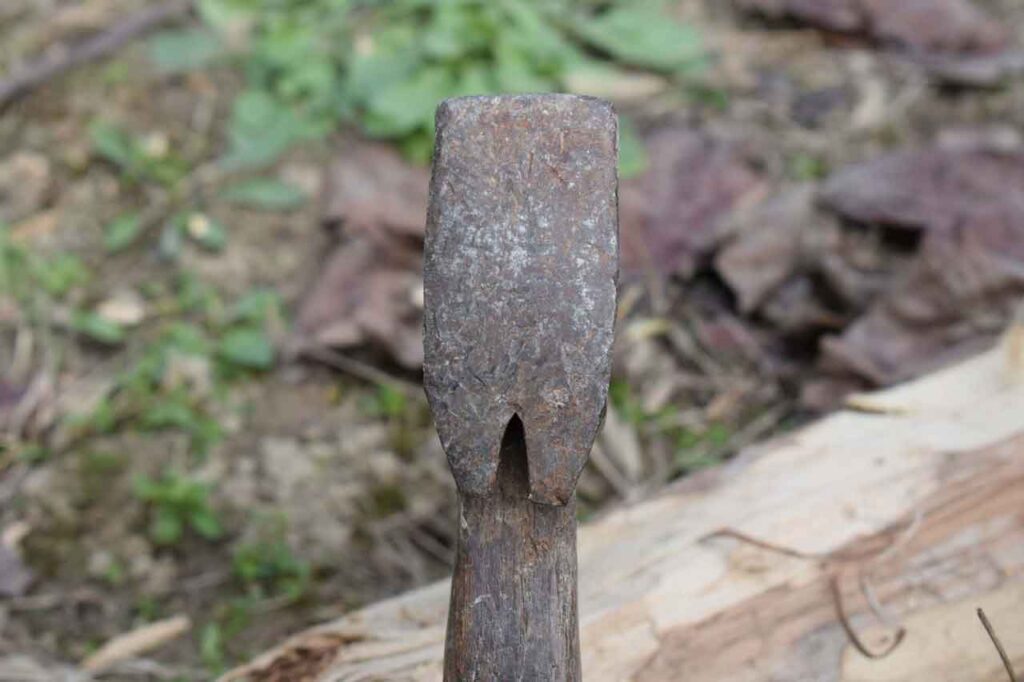
I would say NO, it could potentially warp the eye of the axe, deform the poll, and loosen the axe head from the handle. Most Axes just weren’t designed to be used as hammers. I have used my axe for hammering stakes into the ground, knocking wooden wedges into trees, and other light use. I have never used my axe as a hammer or sledgehammer to pound on materials such as metal nails.
There are exceptions to this of course, if the axe was designed to be used as a hammer, and has a hardened poll or hammerhead as a poll, then it should be fine.
The Eye Of An Axe
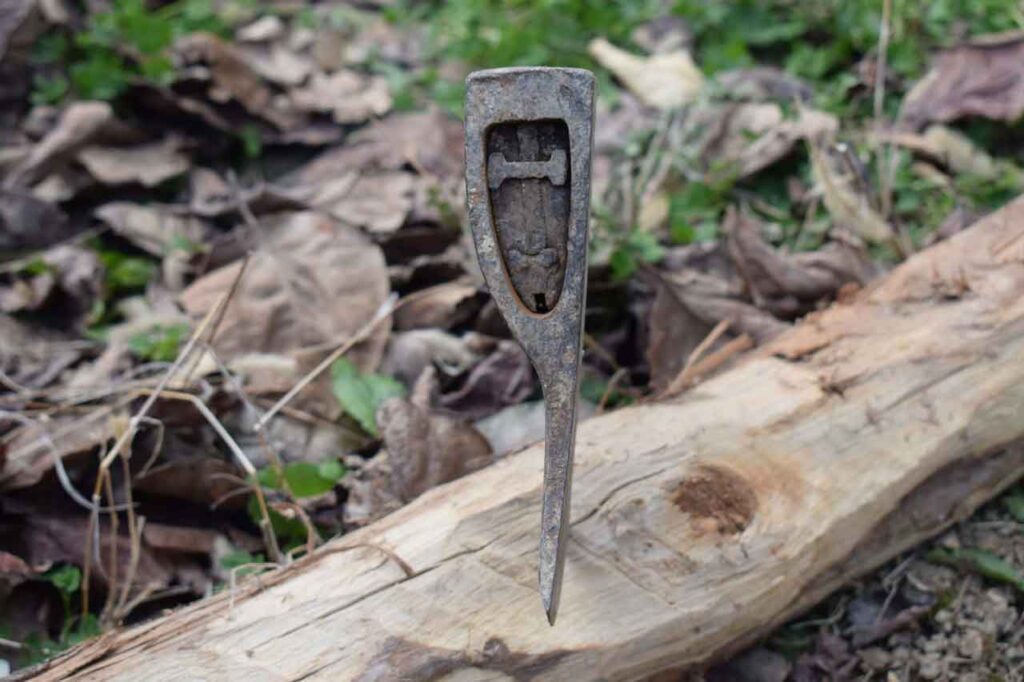
The eye of a traditional axe is what keeps the axe head firmly attached to the handle, before using an axe make sure the eye looks in good condition, that wood hasn’t rotted, that the head isn’t loose, that the wedge in the eye is firmly fixed, that the eye isn’t warped or deformed (usually through misuse).
The Axe Head
The head is the metal part of the axe, the heavier the head the more sturdy and easier it will be to chop wood with, but finer tasks such as carving will be harder, choosing the weight that suits you will be a learning experience as everyone has a different preference, keep in mind that you will be carrying this axe over long distances. My preference is a lighter axe for my bugout bag.
The Axe Beard
A survival axe should have a beard that you can choke up on for finer work and more control.

The Axe Blade
The shape of the axe blade varies wildly, there are some interesting designs on the market, that I would love to try, but if you are unsure of what shape your blade should be, I like the Gransfors Bruk wildlife hatchet design.
Axe Sharpness
How sharp you hone your axe depends on the axe use. If you are using your axe primarily for splitting firewood, it doesn’t need to be razor sharp. But if you are using your axe for chopping wood. Then get it as sharp as you can, many people (me included), keep their chopping axe razor sharp.
Optimal Axe Handle Length
The longer the axe handle, the more swing and power you get out of your axe. The problem with longer handles would be portability and weight.
Best Axe Handle for Survival
Traditionally axe handles have been made of wood. In modern times we have a lot choices, ranging from metal to various types of plastics. Modern materials come with some benefits, and of course a couple of disadvantages. For example: metal handles are much stronger then wood. But the vibrations when chopping, tend to tire the hands out faster then wood, they also weigh more. Plastic handles absorb vibrations better than metal or even wood, but if the handle breaks, the axe is unfixable. Wood is the perfect blend of durability, versatility and convenience.
Best Axe Weight For a B.O.B
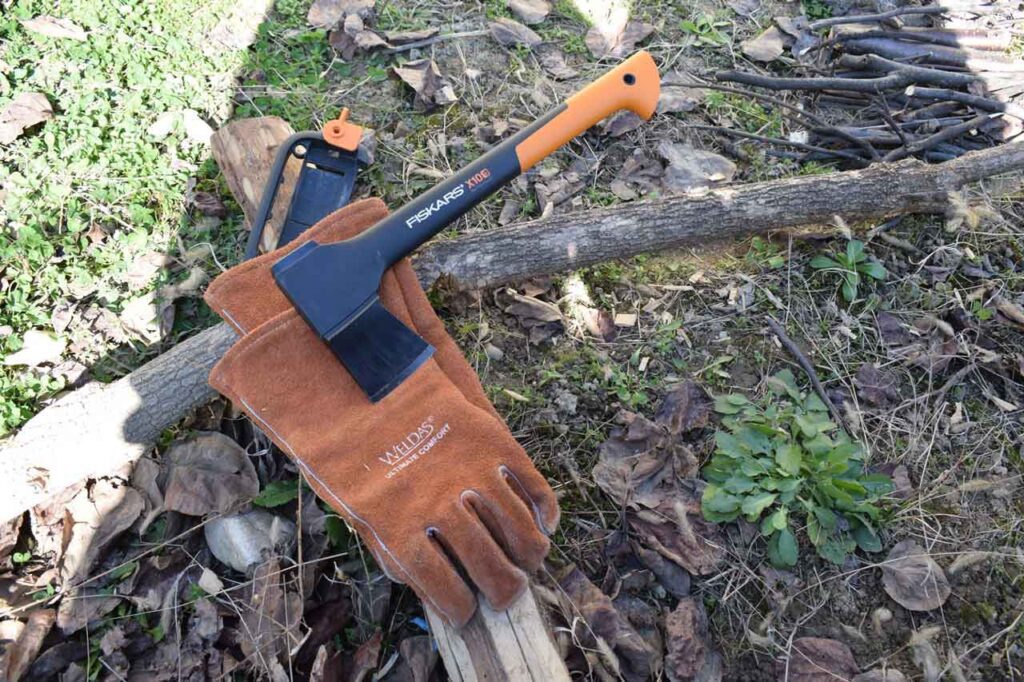
For a B.O.B a lighter axe would be more practical as weight is an important consideration, keep in mind lighter axes are designed for light use. Do not expect to be cutting down large trees with a small axe or hatchet.
Axe Multi Tools
I would heartily discourage anyone from buying a axe multi-tool for a bug-out bag. Multi-tool axes rarely live up to expectations and are generally not as durable as an axe. In fact, there isn’t a single axe multi-tool that hasn’t failed on me yet.
How to Use an Axe
Axe skills aren’t as easy to master as most people think, just hacking away at wood is dangerous. Learn to use proper axe techniques. How to fell a tree, limbing (removing the branches), bucking (chopping the tree into smaller sections), and wood splitting (eg: for firewood).
Axes can also be used to field dress big game, takes more skill than chopping wood though. if you get it wrong it gets really messy.
When using your axe for chopping or splitting wood, always make sure you have a clear space to swing in. That there are no obstructions anywhere around you that might deflect the axe. Make sure that if your axe misses the target, it does NOT swing towards any part of you (eg: your leg). If you are limbing a felled tree, stand to the left of the tree and limb the branches on the right, and vice versa. Do NOT forget to wear safety glasses, flying splinters can be dangerous.
Conclusion:
Like knives, shoes, or bags, the type, size, weight and length of the axe handle is very much a personal choice. I like the feel of the Granfors Bruk Wildlife hatchet, It is compact, light and so danged comfortable to use. It is the perfect size for a bugout bag. If you are looking for a cheaper alternative, I got a Fiskars X10, a great budget choice.
Before buying your axe, think about what you expect it to do, are you going to be chopping big trees? are you going to be using it to build a shelter? to process firewood? to carve with?
Once you have a general idea of what you expect out of your axe, then get the axe for you.